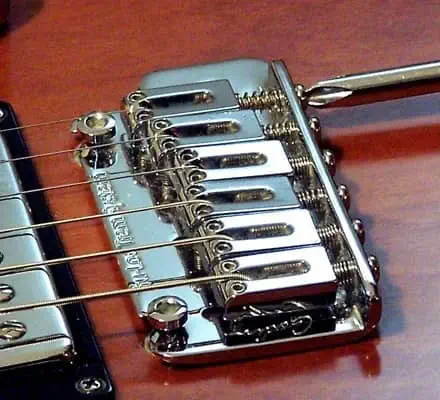
After adjusting the truss rod and the height of the strings, it is time to adjust the intonation of our electric guitar.
Many beginners, and some not-so-beginners, pay their full attention exclusively to tuning their guitar on the open strings, or notes that sound without pressing any frets. Assuming that the guitar will sound in tune anywhere on the fingerboard.
But in reality our instrument can sound really out of tune, in the case of not paying attention to its correct intonation.
Adjust Intonation: Why a guitar can be Badly Intonate?
As the frets of our guitar have a fixed position, the length of the string may be poorly adapted to the arrangement of the frets. In such a case, the result would be the detuning of the notes when we press a certain fret.
To solve this problem, electric guitars have mobile saddles that adapt the length of the string to the arrangement of the frets. So each string has its own adjustment, due to its different gauges.
The 12th fret is right in the middle of the string length, or scale length, increasing the frequency of the vibration to double, at that point. For this reason, at the 12th fret, the same note that we pressed on the open is played again, but one octave higher than the previous note.
If our intonation is not correct, the 12th fret will not play exactly the note in question, and it will sound out of tune.
WRONG

RIGHT
Ok, this is what we must achieve to achieve adequate intonation on our electric guitar.
In other words, we have to ensure that the notes we play open are exactly the same as when we press a note at the 12th fret (that is, the same note that would sound open but an octave higher). And to be able to do this we will need an electronic tuner.
You can use the ONLINE TUNER on the Web to tune your guitar through the microphone, or connected with an adapter.
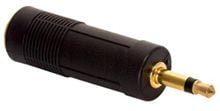
How to Adjust Intonation on an Electric Guitar
If we have a perfectly tuned E note on the first open string, and on the 12th fret we have a slightly lower E, we will have to shorten the scale, moving the saddle closer to the pickups (image above). If it gives us a higher E, we will have to lengthen the scale, moving the saddle away from the first string of the pickups (image below).
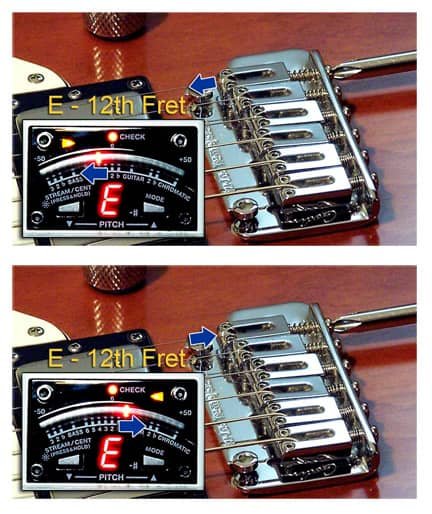
As you can see in the image above, the tuner itself indicates the direction in which we must move the saddle.
We would do the same with the rest of the strings, and we must always loosen the string before each adjustment.
When making an optimal intonation, the saddles acquire a very common ladder arrangement, similar to the one that appears in the image below. So this will give us a clue of the realization of a correct intonation, although this arrangement can vary slightly.
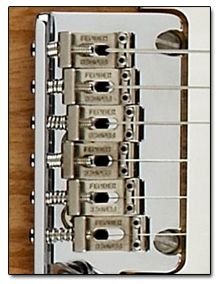
We should always make an intonation adjustment with new strings stabilized in tuning. Since the strings with use suffer wear, lose elasticity, and trap dirt, affecting or hindering the execution of a correct intonation.
In addition, the intonation must be done after having previously adjusted the Truss Rod, and the height of the strings. Since if we modify these settings after adjust the intonation of the electric guitar, it could affect the adaptation made, and we would have to readjust again.
How to Setting Intonation Vintage Tele Bridge?
For Setting Intonation on a Telecaster Electric Guitar with a Vintage Bridge, we can tune only the first, sixth, and fourth strings (image below), or offset the intonation of both strings on the same saddle. In this case, all the strings would have a very slight deviation.

If we change brand or strings gauge, we would have to retouch the intonation. In the event that the neck bowed too much due to heavy string gauges, we would have to modify the truss rod setting.
In any case, even if we don’t change the brand or gauge of strings, it doesn’t hurt to check the intonation of our guitar every six or seven months.
If we change the tuning of our guitar, we should also check the intonation. Since the string tension has varied, and this will affect the intonation.
For this reason it is very common for guitarists to have several identical guitars, with different gauges of strings, or in different tunings, each guitar suitable for its respective settings. Always maintaining a string gauge and a certain tuning, in a specific instrument.
We must bear in mind that the guitar is an “imperfect” instrument. Since the different notes pressed along the fingerboard will have a very slight deviation from the exact tuning of the note in question, except at the 12th fret and open notes.
Multiscale Guitars and Squiggly Frets
Multi-scale guitars with fanned frets, or irregular frets, were designed for further optimization of intonation. But this can also be affected depending on the gauge, manufacturer, and construction materials of the strings.
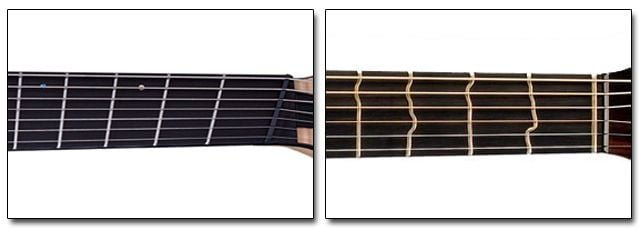
What I want to explain is that if you find that your guitar does not place the tuner exactly in the center in the different notes of the fingerboard, you should know that this is normal. Although it is essential to know the factors that can increase this imperfection, such as bad intonation.
Another factor would be the height of the strings, since the greater the separation that exists between the fret and the string, the more we will have to modify the tension of the string until we reach the fret, which can increase the intonation problem.
In any case, we can adapt the intonation of a guitar to our own needs. For example, if we don’t use the lower part of the fingerboard too much, we can do the intonation at the 10th fret, instead of the 12th. Or if we mainly use chords in the first frets, we can give priority to the intonation in that area of the fretboard.
But also our own way of fingering the notes can affect the intonation. Especially if we press too hard on necks with high frets, or on scalloped fretboard.
In short, the guitar is an imperfectly perfect instrument. Very sensitive to the dynamics or way of playing of the guitarist. Consequently, the same instrument will behave differently in different hands. For this reason, the guitar is a magical instrument, since it offers the possibility of adding flavor, essence, and sensitivity to the performer himself.
